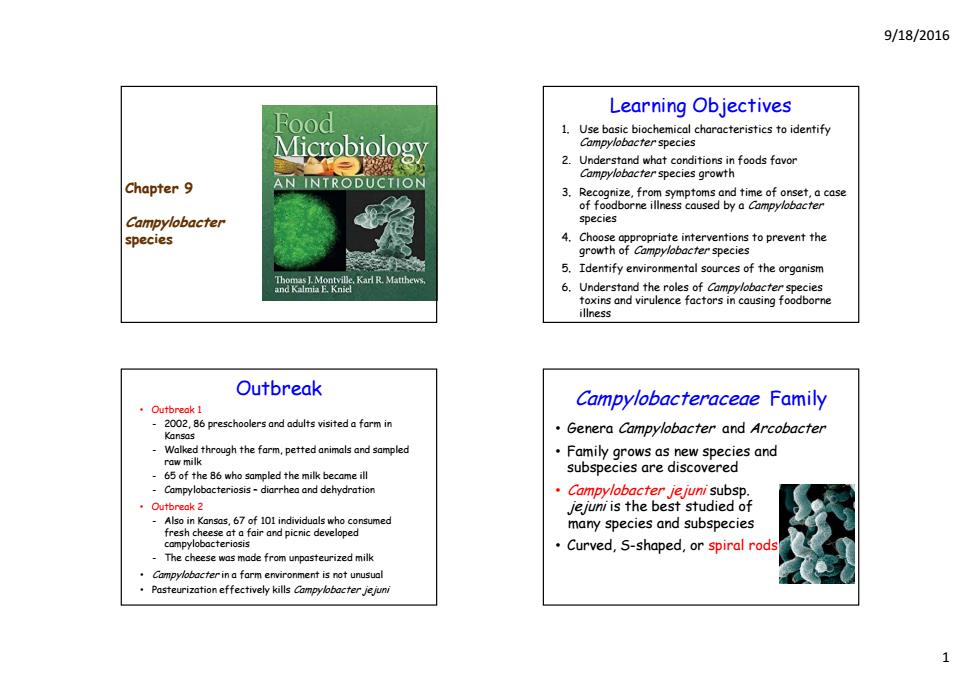
9/18/2016 Learning Objectives Food 1.Use basic biochemical characteristics to identify Microbiology Campylobacter species 2.Understand what conditions in foods favor Chapter 9 AN INTRODUCTION Campylobacter species growth 3.Recognize,from symptoms and time of onset,a case of foodborne illness caused by a Campylobacter Campylobacter species species 4.Choose appropriate interventions to prevent the growth of Campylobacter species 5.Identify environmental sources of the organism 6.Understand the roles of Campylobacter species toxins and virulence factors in causing foodborne illness Outbreak ·Outbreak Campylobacteraceae Family 2002,86 preschoolers and adults visited a farm in Kansas Genera Campylobacter and Arcobacter Walked through the farm,petted animals and sampled raw milk Family grows as new species and 65 of the 86 who sampled the milk became ill subspecies are discovered -Campylobacteriosis diarrhea and dehydration .Campylobacter jejuni subsp. ·Outbreak2 Jjejuni is the best studied of Also in Kansas,67 of 101 individuals who fresh cheese a fair many species and subspecies Curved,S-shaped,or spiral rod The cheese was made from unpasteurized milk Campylobacterin a farm ervironment is not unusual Pasteurization effectively kills Campylobacter jejuni 1
9/18/2016 1 Chapter 9 Campylobacter spec es i Learning Objectives 1. Use basic biochemical characteristics to identify Campylobacter species 2. Understand what conditions in f f oodsavor Campylobacter species growth 3. Recognize, from symptoms and time of onset, a case of foodborne illness caused by a Campylobacter species 4. Choose appropriate interventions to prevent the growth of Campylobacter species 5. Identify environmental sources of the organism 6. Understand the roles of Campylobacter species toxins and virulence factors in causing foodborne illness Outbreak • Outbreak 1 - 2002, 86 preschoolers and adults visited a farm in Kansas - W lk d th h th f tt d i ls d s l d Walked through the farm, petted animals and sampled raw milk - 65 of the 86 who sampled the milk became ill - Campylobacteriosis – diarrhea and dehydration • Outbreak 2 - Also in Kansas, 67 of 101 individuals who consumed fresh cheese at a fair and picnic developed campylobacteriosis - The cheese was made from unpasteurized milk • Campylobacter in a farm environment is not unusual • Pasteurization effectively kills Campylobacter jejuni Campylobacteraceae Family • Genera Campylobacter and Arcobacter • F il i d Family grows as new species and subspecies are discovered • Campylobacter jejuni subsp. jejuni is the best studied of many species and subspecies • Curved, S-shaped, or spiral rods
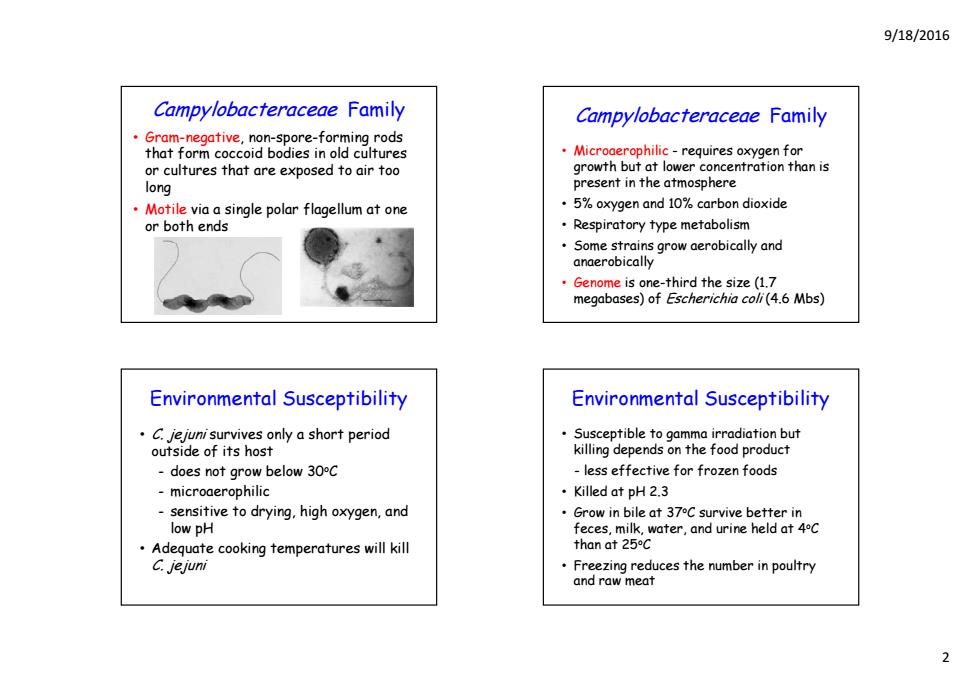
9/18/2016 Campylobacteraceae Family Campylobacteraceae Family Gram-negative,non-spore-forming rods that form coccoid bodies in old cultures Microaerophilic-requires oxygen for or cultures that are exposed to air too growth but at lower concentration than is long present in the atmosphere Motile via a single polar flagellum at one 5%oxygen and 10%carbon dioxide or both ends Respiratory type metabolism Some strains grow aerobically and anaerobically Genome is one-third the size(1.7 megabases)of Escherichia coli(4.6 Mbs) Environmental Susceptibility Environmental Susceptibility .C.jejunisurvives only a short period Susceptible to gamma irradiation but outside of its host killing depends on the food product does not grow below 30C less effective for frozen foods -microaerophilic ·Killed at pH2.3 sensitive to drying,high oxygen,and Grow in bile at 37C survive better in low pH feces,milk,water,and urine held at 4C Adequate cooking temperatures will kill than at 25C C.jejuni Freezing reduces the number in poultry and raw meat
9/18/2016 2 Campylobacteraceae Family • Gram-negative, non-spore-forming rods that form coccoid bodies in old cultures or l h d cultures that are exposed to air too long • Motile via a single polar flagellum at one or both ends • Microaerophilic - requires oxygen for growth but at lower concentration than is Campylobacteraceae Family present in the atmosphere • 5% oxygen and 10% carbon dioxide • Respiratory type metabolism • Some strains grow aerobically and anaerobically • Genome is one-third the size (1.7 megabases) of Escherichia coli (4.6 Mbs) Environmental Susceptibility • C. jejuni survives only a short period out id f it h t tside of its host - does not grow below 30oC - microaerophilic - sensitive to drying, high oxygen, and low pH • Adequate cooking temperatures will kill C. jejuni Environmental Susceptibility • Susceptible to gamma irradiation but killing depends on the food product - less effective for frozen foods • Killed at pH 2.3 • Grow in bile at 37oC survive better in feces milk water and urine held at 4 feces, milk, water, and urine held at 4oC than at 25oC • Freezing reduces the number in poultry and raw meat

9/18/2016 Environmental Susceptibility Reservoirs and Outbreaks Many animals serve as a reservoir Despite its fragility,Campylobacter reservoir:harbors the infectious agent ranks close to Salmone/la in number of without injury to itself and serves as a lab-confirmed cases source from which other individuals can be infected Incidence of illnesses per 100,000 people rabbits,rodents,wild birds,sheep,horses 2013 2012 cows,pigs,poultry,and domestic pets 1.12 Vehicle of infection may include contaminated Non-0157 STEC 1.17 1,16 vegetables and shellfish Listeria 0.26 0.25 Campylobocter 13.82 14.30 Water and water supplies may be a source of 15.19 16.42 infection Routes of transmission for Campylobacter jejuni 三
9/18/2016 3 Environmental Susceptibility • Despite its fragility, Campylobacter ranks close to Salmonella in number of lab-confirmed cases Reservoirs and Outbreaks • Many animals serve as a reservoir - reservoir: harbors the infectious agent without injury to itself and serves as a source from which other individuals can be infected - rabbits, rodents, wild birds, sheep, horses, cows, pg p y p igs, poultry, and domestic pets • Vehicle of infection may include contaminated vegetables and shellfish • Water and water supplies may be a source of infection Routes of transmission for Campylobacter jejuni Christina Bronowski et al. FEMS Microbiol Lett 2014;356:8-19
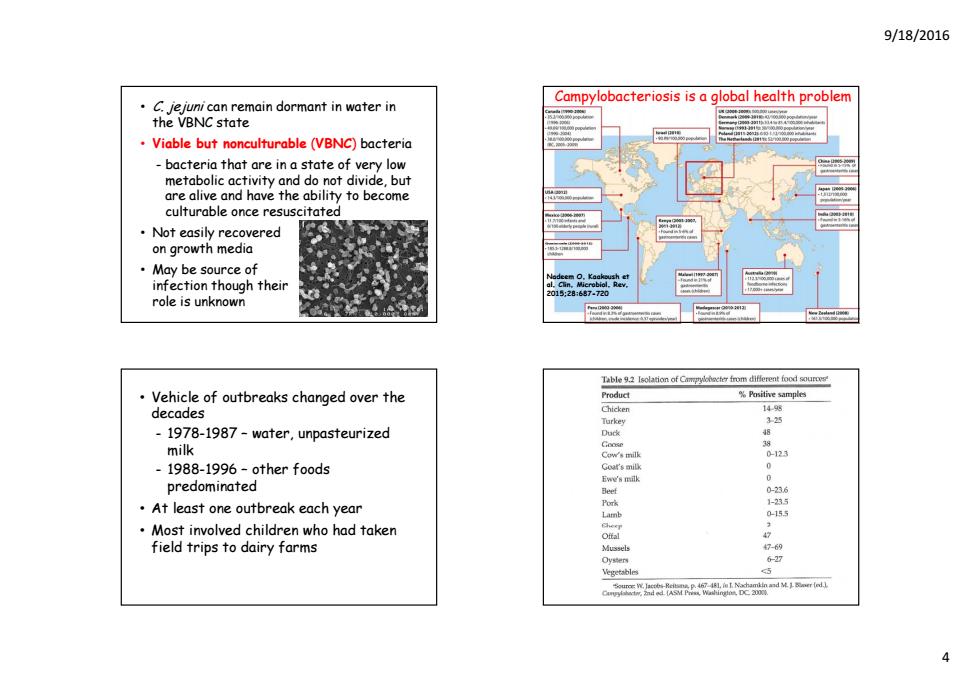
9/18/2016 Campylobacteriosis is a global health problem C.jejuni can remain dormant in water in the VBNC state Viable but nonculturable(VBNC)bacteria bacteria that are in a state of very low metabolic activity and do not divide,but are alive and have the ability to become culturable once resuscitated ·Not easily recovered on growth media ·May be source of infection though their :28:657.720 role is unknown Vehicle of outbreaks changed over the Product %Positive samples tg decades 325 -1978-1987-water,unpasteurized 3 milk Cow's milk 123 -1988-1996-other foods Goat's milk 0 Ewe's milk predominated 0-236 At least one outbreak each year 1-235 Lamb 0-155 Most involved children who had taken field trips to dairy farms Mussels 5
9/18/2016 4 • C. jejuni can remain dormant in water in the VBNC state • Viable but nonculturable (VBNC) bacteria - bacteria that are in a state of very low metabolic activity and do not divide, but are alive and have the ability to become culturable once resuscitated • Not easily recovered on h di growth media • May be source of infection though their role is unknown Campylobacteriosis is a global health problem Nadeem O. Kaakoush et al. Clin. Microbiol. Rev. 2015;28:687-720 • Vehicle of outbreaks changed over the decades - 1978-1987 – water, unpasteurized milk - 1988-1996 – other foods predominated • At least one outbreak each year • M t i l d hild h h d t k Most involved children who had taken field trips to dairy farms

9/18/2016 2014 FOOD SAFETY PROGRESS REPORT Estimated 800,000 cases of 4a古学 campylobacteriosis in the US each year © 8 Most common foodborne infections in 2014 were: ▣ 05段 © Salmonella(38%) ▣ 64 ⑨ Campylobacter (33%) 回 E.coli(6%) ⑨ 045 8 2014,a stall in reducing occurrences of © Campylobacter and Salmonella Disease Characteristics Patients may be asymptomatic or showing no signs of illness to severely ill Symptoms usually include C jejuni and C.coli -fever Gastrointestinal tract infections -abdominal cramping Most common Campylobacter species -diarrhea with or without blood associated with diarrheal illness Lasts from several days ·Indistinguishable to>1 week In US,an estimated 5%-10%of cases Usually self-limiting attributed to C.jejuni are actually due Relapse occurs in 5-10% to C.coli of untreated patients Recurrence of abdominal pain is common
9/18/2016 5 • Estimated 800,000 cases of campylobacteriosis in the US each year • Most common foodborne infections in 2014 were: - Salmonella (38%) - Campylobacter (33%) - E. coli (6%) • 2014, a stall in reducing occurrences of Campylobacter and Salmonella Disease Characteristics C. jejuni and C. coli • Gastrointestinal tract infections • Most common Campylobacter species associated with diarrheal illness • Indistinguishable • I US i d 5% In US, an estimated 5%-10% f o cases attributed to C. jejuni are actually due to C. coli • Patients may be asymptomatic or showing no signs of illness to severely ill • Symptoms usually include - fever - abdominal cramping - diarrhea with or without blood • Lasts from several days to > 1 week • Usually self-limiting • Relapse occurs in 5-10% of untreated patients • Recurrence of abdominal pain is common

9/18/2016 Other diseases caused by C jejuniand C.coli ·bacteremia Antibiotic Treatment ·bursitis C.jejuni and C.coli are still susceptible urinary fract infection meningitis to many antibiotics ·endocarditis Early therapy is effective in eliminating ·peritonitis Campylobacter species from feces and ·pancreatitis reducing symptoms ·abortion neonatal sepsis Resistant strains have emerged likely ·reactive arthritis due to antibiotic use in poultry Guillain-Barre syndrome FDA banned use of fluoroguinolones in poultry Deaths attributed to C jejuniare rare Epidemiological Subtyping Systems Serotyping .Identify types of bacteria based on Ty semioloay of antigens Heat-labile and O-antigens ·Biotyping Serotyping Bacteriocin sensitivity ·Enzyme detection Lectin binding ·Phage typing Biotyping Multilocus enzyme electrophoresis ·Identifying types of Pulsed Field Gel Electrophoresis PFGE microorganisms based on ·Ribotyping differentiable physiologic Restriction fragment length polymorphism RFLP characteristics Polymerase chain reaction PCR 6
9/18/2016 6 Other diseases caused by C. jejuni and C. coli • bacteremia • bursitis • urinary tract infection • meningitis • endocarditis • peritonitis • pancreatitis • abortion • neonatal sepsis • reactive arthritis • Guillain-Barré syndrome Deaths attributed to C. jejuni are rare Antibiotic Treatment • C. jejuni and C. coli are still susceptible to many antibiotics • Early therapy is effective in eliminating Campylobacter species from feces and reducing symptoms • Resistant strains have emer g y ed likel y due to antibiotic use in poultry • FDA banned use of fluoroquinolones in poultry Epidemiological Subtyping Systems Typing systems devised to study epidemiology of Campylobacter infections • Biotyping • Serotyping • Bacteriocin sensitivity • Enzyme detection • Lectin binding • Phag yp g e typing • Multilocus enzyme electrophoresis • Pulsed Field Gel Electrophoresis PFGE • Ribotyping • Restriction fragment length polymorphism RFLP • Polymerase chain reaction PCR Serotyping • Identify types of bacteria based on antigens • Heat-labile and O-antigens Biotyping • Identifying types of microorganisms based on differentiable physiologic characteristics
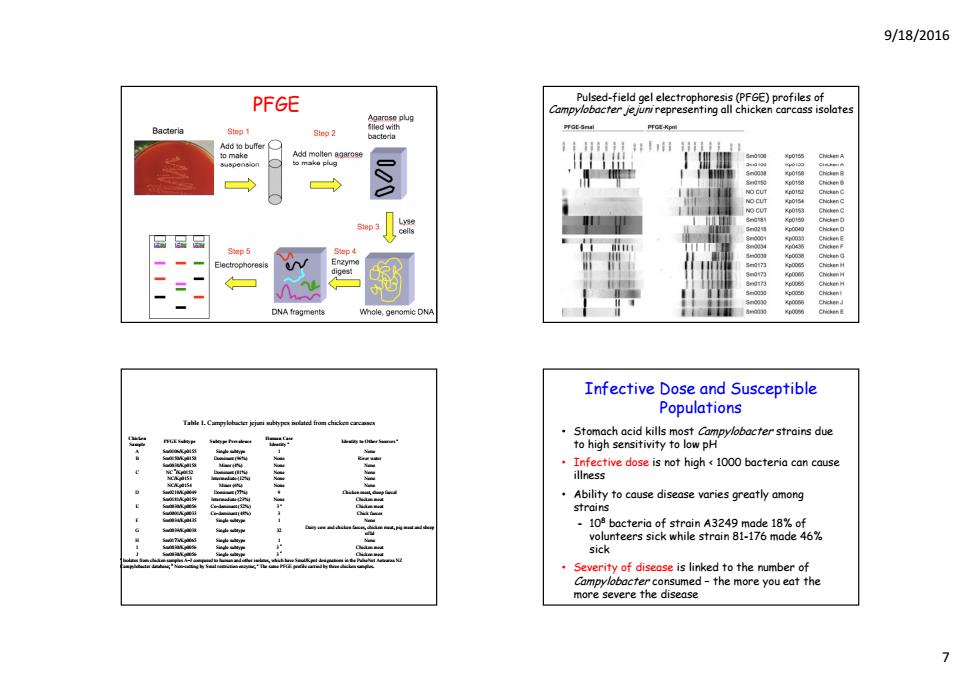
9/18/2016 PFGE Pulsed-field gel electrophoresis(PFGE)profiles of Campylobacter nirepresenting all chicker cass isolates Bacteria Sto 1 PFOE-Smal acteria o mak hmaengar9 ym DNA fragments Infective Dose and Susceptible Populations Stomach acid kills most Campylobacter strains due to high sensitivity to low pH Infective dose is not high 1000 bacteria can cause illness Ability to cause disease varies greatly among strains 108 bacteria of strain A3249 made 18%of volunteers sick while strain 81-176 made 46% sick Severity of disease is linked to the number of Campylobacter consumed-the more you eat the more severe the disease >
9/18/2016 7 PFGE Pulsed-field gel electrophoresis (PFGE) profiles of Campylobacter jejuni representing all chicken carcass isolates Table 1. Campylobacter jejuni subtypes isolated from chicken carcasses Chicken Sample PFGE Subtype Subtype Prevalence Human Case Identity a Identity to Other Sources a A Sm0106/Kp0155 Single subtype 1 None B Sm0150/Kp0158 Dominant (96%) None River water Sm0038/Kp0158 Minor (4%) None None C NC b/Kp0152 Dominant (81%) None None NC/Kp0153 Intermediate (12%) None None NC/Kp0154 Minor (6%) None None D Sm0218/Kp0049 Dominant (77%) 9 Chicken meat, sheep faecal Sm0181/Kp0159 Intermediate (23%) None Chicken meat E Sm0030/Kp0056 Co-dominant (52%) 3 c Chicken meat Sm0001/Kp0033 Co-dominant (48%) 3 Chick faeces F Sm0034/Kp0435 Single subtype 1 None D i d hi k f hi k t i t d h G Sm0039/Kp0038 Single subtype 32 Dairy cow and chicken faeces, chicken meat, pig meat and sheep offal H Sm0173/Kp0065 Single subtype 1 None I Sm0030/Kp0056 Single subtype 3 c Chicken meat J Sm0030/Kp0056 Single subtype 3 c Chicken meat a Isolates from chicken samples A–J compared to human and other isolates, which have SmaI/KpnI designations in the PulseNet Aotearoa NZ Campylobacter database; b Non-cutting by SmaI restriction enzyme; c The same PFGE profile carried by three chicken samples. Infective Dose and Susceptible Populations • Stomach acid kills most Campylobacter strains due to high sensitivity to low pH • Infective dose is not high < 1000 bacteria can cause illness • Ability to cause disease varies greatly among strains - 108 bacteria of strain A3249 made 18% of volunteers sick while strain 81-176 made 46% sick • Severity of disease is linked to the number of Campylobacter consumed – the more you eat the more severe the disease
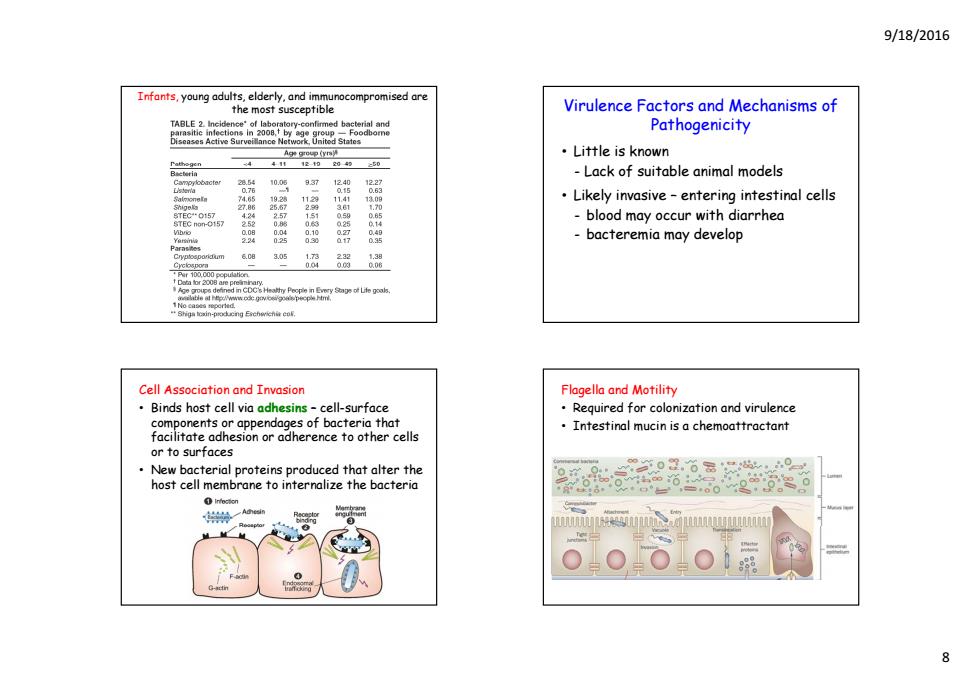
9/18/2016 Infants,young adults,elderly,and immunocompromised are the most susceptible Virulence Factors and Mechanisms of paweond Pathogenicity Active Surve United States ·Little is known Lack of suitable animal models 10.06 93 122 Likely invasive -entering intestinal cells blood may occur with diarrhea bacteremia may develop 3.05 Cell Association and Invasion Flagella and Motility Binds host cell via adhesins-cell-surface Required for colonization and virulence components or appendages of bacteria that Intestinal mucin is a chemoattractant facilitate adhesion or adherence to other cells or to surfaces New bacterial proteins produced that alter the host cell membrane to internalize the bacteria 46 ww.Fwnm wwww ○1
9/18/2016 8 Infants, young adults, elderly, and immunocompromised are the most susceptible Virulence Factors and Mechanisms of Pathogenicity • Little is known - Lack f bl l d l k of suitable animal models • Likely invasive – entering intestinal cells - blood may occur with diarrhea - bacteremia may develop Cell Association and Invasion • Binds host cell via adhesins – cell-surface components or appendages of bacteria that facilitate adhesion or adherence to other cells or f to surfaces • New bacterial proteins produced that alter the host cell membrane to internalize the bacteria Flagella and Motility • Required for colonization and virulence • Intestinal mucin is a chemoattractant
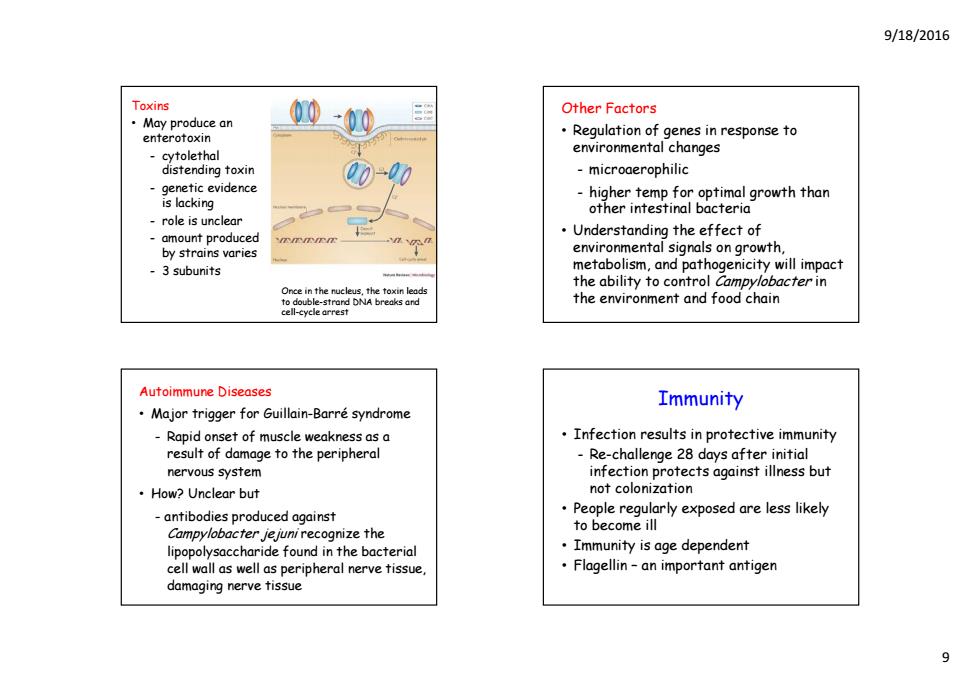
9/18/2016 Toxins Other Factors ·May produce an enterotoxin Regulation of genes in response to -cytolethal environmental changes distending toxin 00-0 -microaerophilic genetic evidence higher temp for optimal growth than is lacking other intestinal bacteria -role is unclear -amount produced Understanding the effect of TITIITIT by strains varies environmental signals on growth, 、 3 subunits metabolism,and pathogenicity will impact the ability to control Campylobacter in Once in the nucleus the environment and food chain Autoimmune Diseases Immunity Major trigger for Guillain-Barre syndrome Rapid onset of muscle weakness as a Infection results in protective immunity result of damage to the peripheral -Re-challenge 28 days after initial nervous system infection protects against illness but ·How?Unclear but not colonization antibodies produced against People regularly exposed are less likely to become ill Campylobacter jejuni recognize the lipopolysaccharide found in the bacterial Immunity is age dependent cell wall as well as peripheral nerve tissue Flagellin-an important antigen damaging nerve tissue 9
9/18/2016 9 Toxins • May produce an enterotoxin - cytolethal distending toxin - genetic evidence is lacking - role is unclear - amount produced by strains varies - 3 subunits Once in the nucleus, the toxin leads to double-strand DNA breaks and cell-cycle arrest Other Factors • Regulation of genes in response to environmental changes - mi hili croaerophili c - higher temp for optimal growth than other intestinal bacteria • Understanding the effect of envi t l i l th ironmen t al signals on growth, metabolism, and pathogenicity will impact the ability to control Campylobacter in the environment and food chain Autoimmune Diseases • Major trigger for Guillain-Barré syndrome - Rapid onset of muscle weakness as a result of damage to the peripheral nervous system • How? Unclear but - antibodies produced against Campylobacter jejuni recognize the lipopolysaccharide found in the bacterial cell wall as well as peripheral nerve tissue, damaging nerve tissue Immunity • Infection results in protective immunity - Re-challenge 28 days after initial infection protects against illness but not colonization • People regularly exposed are less likely to become ill • Immunity is age dependent • Flagellin – an important antigen

9/18/2016 Strategies to Prevent the Spread of Infection How can you avoid it? Improved hygiene practices during broiler production 50. Use competitive exclusion floras to prevent colonization of chicks ·Animal vaccines 60170= FDA Approves Campylobacter Vaccine for Human Trials -2014 Food Safety News article based on capsule polysaccharide Summary Summary Campylobacteriosis linked to Campylobacter infection is a major consumption of contaminated food is trigger of Guillain-Barre syndrome the most prevalent form of foodborne Motility is essential for colonization illness in the United States Five to 10%of cases attributed to C. Campylobacter je juni is commonly Jejuni are actually due to C.coli isolated from poultry Thermoprocessing easily inactivates The infective dose of C.jejunimay be less than 1000 cells campylobacters 10
9/18/2016 10 Strategies to Prevent the Spread of Infection • Improved hygiene practices during b il d ti broiler production • Use competitive exclusion floras to prevent colonization of chicks • Animal vaccines • FDA Approves Campylobacter Vaccine for Human Trials – 2014 Food Safety News article - based on capsule polysaccharide Summary • Campylobacteriosis linked to consumpti f t i t d f d i tion of contaminated food is the most prevalent form of foodborne illness in the United States • Campylobacter jejuni is commonly isolated from poultry • Thermoprocessing easily inactivates campylobacters Summary • Campylobacter infection is a major t i f trigger of G ill i Guillain-B éarr syndrome • Motility is essential for colonization • Five to 10% of cases attributed to C. jejuni are actually due to C. coli • The infective dose of C. jejuni may be less than 1000 cells